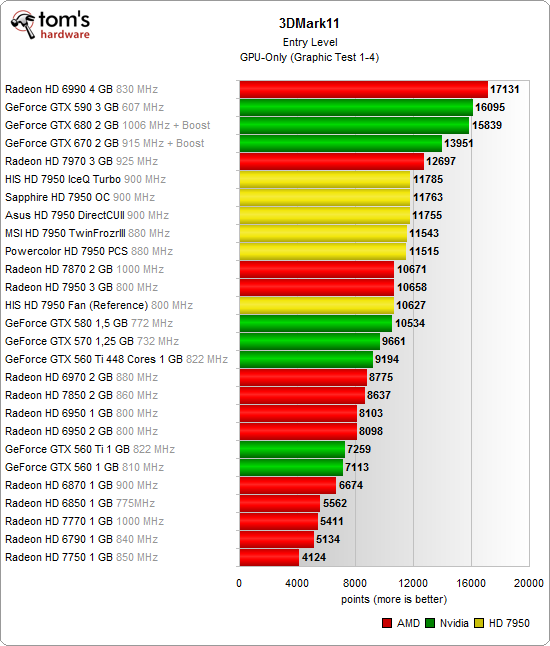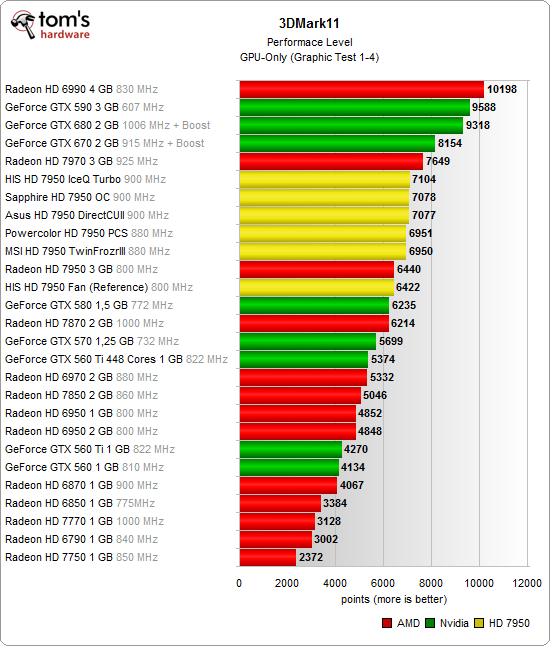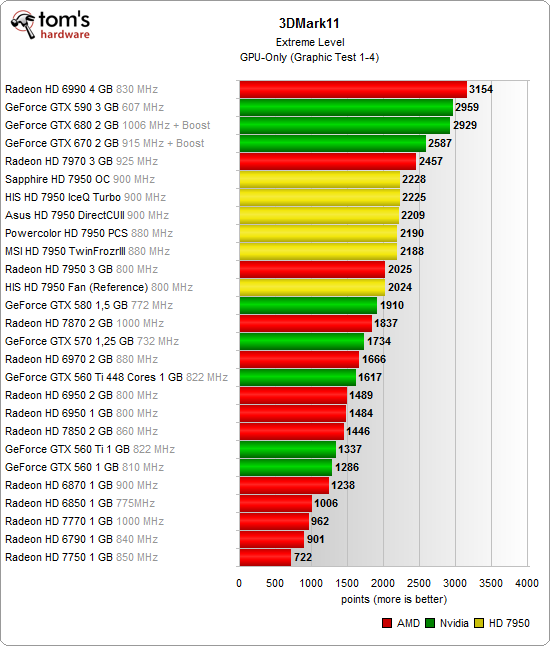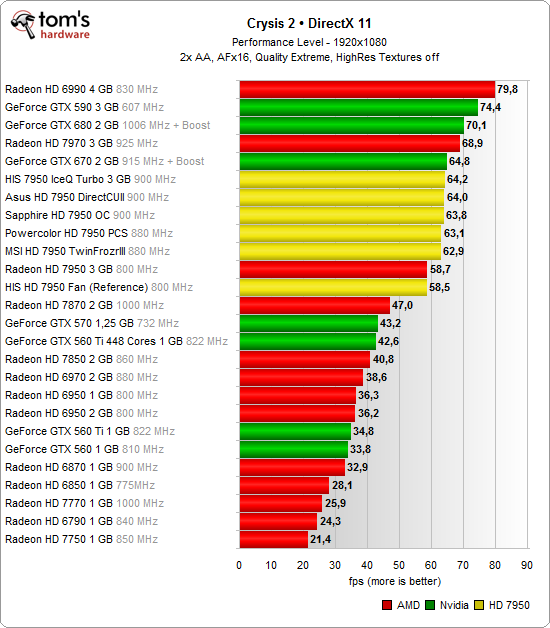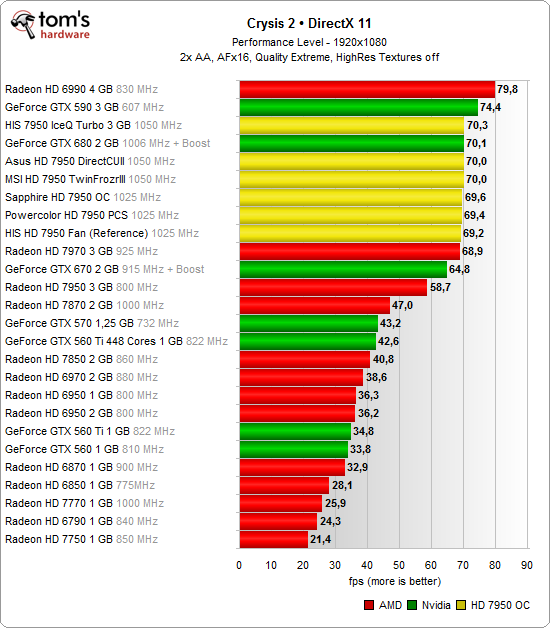Radeon HD 7950 3 GB: Six Cards, Benchmarked And Reviewed
With Nvidia's GeForce GTX 670 readily available for $400, AMD's Radeon HD 7950 shifts to the upper middle class of graphics card performance. We test six third-party interpretations in anticipation of pricing more in line with its competitive position.
Benchmark Results And Overclocking
3DMark 11
It barely makes a difference if a Radeon HD 7950 is clocked at 880 MHz or 900 MHz in 3DMark 11. Compare to AMD's reference 800 MHz, however, and the distinction is much clearer.
All of these boards lose to Nvidia's GeForce GTX 670, though, even though HIS' HD 7950 IceQ Turbo almost manages to catch up to it in Crysis 2. Unfortunately, four of these six boards cost more than the $400 GTX 670, hurting their value proposition against the competition.
Crysis 2 (DirectX 11)
Overclocking
We overclocked each card as much as possible without increasing their voltage settings. Half of them managed to hit 1050 MHz, while the other half maxed out at 1025 MHz.
Bear in mind that doing this pushes power consumption into Radeon HD 7970 territory, though performance is also able to exceed a GeForce GTX 670 in Crysis 2. HIS' HD 7950 IceQ Turbo even manages to edge out the GeForce GTX 680 by two-tenths of a frame per second. The caveats, of course, are that the GeForce-based cards were running at their stock frequencies and that factory-overclocked versions of those cards are already available, too. Moreover, Crysis 2 is a game that scales well with GPU clock rate, and it's known to work well on AMD's hardware. Titles like Battlefield 3 and DiRT 3, which favor Nvidia-based board, instead show the GeForces on top.
Get Tom's Hardware's best news and in-depth reviews, straight to your inbox.
Current page: Benchmark Results And Overclocking
Prev Page Noise Comparison Videos Next Page Which Radeon HD 7950 Is Right For You?
Igor Wallossek wrote a wide variety of hardware articles for Tom's Hardware, with a strong focus on technical analysis and in-depth reviews. His contributions have spanned a broad spectrum of PC components, including GPUs, CPUs, workstations, and PC builds. His insightful articles provide readers with detailed knowledge to make informed decisions in the ever-evolving tech landscape
-
mayankleoboy1 in some of the earlier charts, gtx680 is written as "gtx 680 1536MB".Reply
also, gtx580 seems to be missing in the crysis2 charts. -
Just thought you might like to know that the x-axis captions for the noise level graphs are labelled as they would be for temperature, rather than decibelsReply
-
scrumworks That nvidia turbo boost is a bit cheating and you should turn it off for the test. It's basically same as overclocking and your review sample cards are most likely binned to get much better than average OC.Reply -
jimmysmitty Why was there no expanded information on the overclocking ability of the GPUs? Half at 1025MHz and Half at 1050MHz doesn't help anything.Reply
As well, what kind of memory overclocks did you get? Did you have to change the voltage of the GPUs to get said clock speeds?
This article was missing a bit too much info there to really be able to get the full picture of these GPUs. The HD7970 6 card shootout is how it should have been done for the HD7950s. Each cards overclocking ability (core/memory) and what they got with stock voltage and overvolted. -
mayankleoboy1 scrumworksThat nvidia turbo boost is a bit cheating and you should turn it off for the test. It's basically same as overclocking and your review sample cards are most likely binned to get much better than average OC.Reply
WOW.
how is it cheating? it is cheating only if the average user will not use the "GPU boost" feature, but reviewers are using it.
and, the card is faster, cheaper and cooler than the competition. so if you are better, you cheat?Fanboi. -
SessouXFX XFX HD7950 didn't make the list?Reply
You know what this is like? Imagine yourself as a concert prompter, trying to put a lineup together. You have Megadeth, White Snake, Poison, Guns -n- Roses, AC DC, you think you're doing just fine...What? Metallica wanted nothing to do with that roundup of Who's Who? Did they turn you down, or did you guys turn them down?
Because XFX matters. XFX always matter! And I'm pretty sure they weren't scared to step into the ring and beat some heads in with a comparo with the best in the biz. You guys need to get in touch with them and test their HD7950 and see if their card has the potential to blast that "elephant in the room" and hang it's head on the wall.
This is Tom's Hardware after all... -
we_san scrumworksThat nvidia turbo boost is a bit cheating and you should turn it off for the test. It's basically same as overclocking and your review sample cards are most likely binned to get much better than average OC.You want to add 7970 OC into the crowd ? Just ask ...Reply -
Deemo13 I really like the charts posted for the benchmarking! Gives a much wider range of cards.Reply
